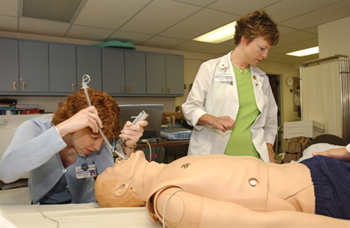
VUSN instructor Jennifer Ezell, left, learns firsthand how her students will be able to practice intubation and establishing an airway on SimMan in a training session in a Godchaux Hall skills lab, while Instructor Terri Donaldson, MSN, right, looks on. Photo by Anne Rayner
Nursing students to learn procedures on new life-like patient simulator
Starting this fall, students in the School of Nursing will be learning how to perform procedures on a man they call Sim. That’s short for SimMan™, a simulated training mannequin that talks, breathes, moans and even dies, just like a real patient.
SimMan™ is made by Laerdal Medical Corporation™, a company that specializes in mannequins and other tools that simulate patient care. Linda Norman, DSN, senior associate dean for Academics, said using technology like SimMan™ will help VUSN offer more realistic training to nursing students.
“The purpose of using technology like this is in the area of error prevention and to provide a simulated experience for complex scenarios and procedures for students. It gives them more of an opportunity to develop their skill level, rather than only depending on the opportunities that they have in the inpatient environment,” Norman said.
Taking advantage of technology like this also puts the nursing school on track with a new move in healthcare to address errors and patient safety in ways similar to the aviation industry. Joe Huse, a simulation specialist with Laerdal™ said healthcare is just now catching up to other industries using simulation training like the SimMan™ technology. “The airline industry has been using simulation since the 1940s,” Huse said.
SimMan™ allows students to learn and practice airway placement, external defibrillation, IV placement with replaceable skin and veins, injections and chest compressions. Students can check a pulse or blood pressure, listen to lung, heart, and bowel sounds, and the simulator can even cough, vomit, moan and make other lifelike vocal sounds. Maria Overstreet, MSN, who was instrumental in bringing SimMan™ to VUSN, will be using him in her classes this fall.
“I think it offers a more personalized approach. He responds to your voice. You can takes tubes out, place a central line, a chest tube, and even intubate. It’s realistic,” said Overstreet.
She said the simulator will allow instructors to program the mannequin to test students on specific procedures and different scenarios.
“For instance, say we want him to display a certain heart rhythm, like ventricular tachycardia. If it shows up on the monitor and they don’t catch it, we will know. It will provide training that in the past students would do on a mannequin and faculty couldn’t really evaluate their performance, because there was no way to record each of their interventions,” Overstreet added.
Here’s how the technology works: Plug SimMan™ into the wall, and he lives and breathes with the help of a computer program. Instructors can control him by using a mouse or a remote control. Each function can be programmed and set to occur at any point in the examination or procedure being performed by a student, and instructors can tailor the programs to their own specific scenario.
SimMan™ also comes with an event log that can be saved or printed to monitor and track each student’s performance and skill level. A monitor is equipped to show respiratory rate, arterial waveform, heart rate and temperature readings.
Optional devices can be purchased at any time to provide additional training resources, like trauma modules to demonstrate wound care, and Huse said Laerdal™ is already distributing infant and child simulators, as well as a pregnancy simulator that actually delivers a baby. SimMan™ can also run off of a battery pack, making him portable for scenarios in the field. The military is currently using more than 300 SimMan™ units for training missions all over the world.
Marion Young, a Marketing Manager with Laerdal™, said about 165 other nursing schools are currently using the SimMan™ technology, as well about 25 medical schools. VUSN purchased the SimMan™ for $30,000, with plans to introduce him to students in a variety of nursing courses this fall.













